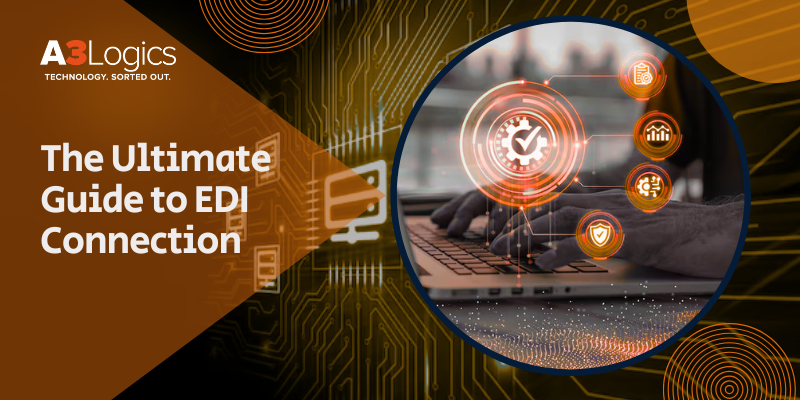More than 85% of Fortune 500 companies are today using EDI Connections. Not only this, the ones who are using EDI report, are able to process the order 60% better. In fact, while doing this, they are also going to benefit from 30% reduction in transaction errors.
So, this shows how EDI has become one of the primary elements to succeed in digital business communication. It allows companies to exchange data without any kind of difficulty. In fact, all of it is done while maintaining the speed, accuracy, and even the security.
If you are thinking about investing in an EDI connection, then you can consider going through the guide here. We are going to help you with all the knowledge you need related to EDI connection.

Table of Contents
What is EDI Connection?
A safe, automated link between two or more companies, called an EDI Connection, allows the electronic transfer of commercial documents in specified forms. Rather than depending on emails, faxes, or postal mail, businesses utilize EDI Connections to send documents like purchase orders, invoices, and shipment notifications directly between their internal systems and their trading partners.
Globally accepted standards (such ANSI X12 and UN/EDIFACT) control this procedure, hence guaranteeing consistent data interpretation by all involved. The outcome is a significant decrease in human data entry, less mistakes, and far quicker business cycles.
> EDI Connection Definition
An EDI Connection is the technical and procedural infrastructure that allows for the secure, automated, and standardized exchange of electronic business documents between trading partners. This can be achieved through direct (point-to-point) connections, via third-party Value-Added Networks (VANs), or through cloud-based EDI services.
How Does an EDI Connection Work?
It is important that you understand how EDI Connections are functioning and are going to help businesses enhance their operations. Here’s a step-by-step breakdown:
1. Data Translation
Specialized EDI software converts internal corporate documents, such as purchase orders, into a standardized EDI format. This conversion guarantees that, regardless of their internal systems, both sender and recipient may correctly understand the data.
2. Transmission
Secure methods like AS2, SFTP, FTPS, or via a VAN send the EDI document to the trading partner. During transmission, these protocols guarantee data integrity and secrecy.
3. Receipt and Integration
The document is validated and converted back into the recipient’s internal format upon reception. The data is subsequently included into their business systems, ready for processing without manual involvement.
4. Automation and Acknowledgment
Many times, EDI Connections have automated acknowledgment messages verifying successful reception and processing, which helps to simplify operations even more.
Why Does Your Business Need a Strong EDI Connection?
A robust EDI Connection offers several compelling advantages:
- Speed: Transactions that once took days can now be completed in minutes, enabling real-time business operations.
- Accuracy: Standardized formats and automation drastically reduce errors caused by manual data entry.
- Cost Efficiency: Businesses report up to 40% lower administrative costs due to reduced paperwork and faster processing.
- Compliance: Many large organizations require their suppliers to be EDI Capable as a condition for doing business.
- Scalability: EDI Connections make adding new trading partners and transaction types easy as your business grows.
- Competitive Advantage: Faster, more accurate communication leads to better customer service and stronger supplier relationships.

How to Set Up an EDI Connection with Trading Partners
Establishing EDI Connections involves a series of strategic and technical steps. Here’s an expanded guide:
1. Identify EDI Needs
- Assess which business documents (such as purchase orders, invoices, EDI Payments, and shipping notices) you need to exchange electronically.
- Determine which trading partners require EDI integration and identify any industry-specific standards (e.g., EDI 834 solutions for healthcare).
2. Choose the Right EDI Solution
- Decide whether to manage EDI in-house using EDI software, or outsource to a provider offering EDI consulting services.
- Consider scalability, integration capabilities, and support for your industry’s standards.
3. Establish Communication Protocols
- Select secure methods for data transmission, such as AS2, SFTP, FTPS, or VPN connections.
- Ensure both internal and partner systems support the chosen protocols and that all connections are encrypted and authenticated.
4. Data Mapping
- Map your internal data fields to the required EDI formats. This ensures that data is correctly translated and interpreted on both ends.
- Use EDI mapping tools to create templates for each document type, minimizing the need for custom programming.
5. Testing
- Conduct comprehensive testing with your trading partners to ensure data is exchanged accurately and efficiently.
- Simulate real-world transactions and resolve any issues before going live.
6. Go Live
- Once testing is successful, move to production. Monitor the EDI Connection closely during the initial phase to quickly address any issues.
7. Ongoing Maintenance
- Regularly review and update your EDI Connections to maintain security, compliance, and compatibility with trading partner requirements.
- Provide ongoing training for your team to ensure they remain proficient with EDI processes.
Benefits of Using EDI Connections in Supply Chain Management
EDI Connections are transformative for supply chain operations. Here’s how:
1. Real-Time Inventory Updates
As transactions take place, EDI Connections give companies fast, precise notifications on inventory levels. This implies that the inventory count is automatically changed in real time when a product is sold or received. Companies therefore always know precisely what is in stock, which helps to avoid both excess inventory and shortages. Better planning, prompt restocking, and guarantees that popular items are always available for consumers all result from this degree of visibility, hence enhancing general efficiency and customer happiness.
2. Faster Order Processing
With EDI Connections, the entire order process becomes automated-from receiving a purchase order to sending an invoice. This automation eliminates the need for manual data entry, which can be slow and error-prone. Orders are transmitted and processed instantly, reducing the order cycle time by up to 60%. This speed enables companies to fulfill orders much faster, leading to quicker deliveries, happier customers, and the ability to handle a higher volume of transactions without increasing staff or resources.
3. Reduced Stockouts and Overstocks
EDI Connections enhance visibility across the supply chain by providing timely and accurate information about inventory and orders. This allows businesses to forecast demand more precisely and maintain optimal stock levels. As a result, companies can avoid the costly problems of running out of popular items (stockouts) or tying up capital in excess inventory (overstocks). Improved forecasting and inventory management lead to better service levels, reduced waste, and increased profitability.
4. Better Supplier Relationships
By enabling reliable and timely communication, EDI Connections help build stronger, more collaborative relationships with suppliers. Automated data exchange reduces misunderstandings and delays, ensuring that both parties are always on the same page regarding orders, shipments, and payments. This transparency and efficiency foster trust, make it easier to resolve issues quickly, and can lead to preferential treatment, better pricing, or more flexible terms from suppliers, all of which are beneficial to long-term business success.
5. Lower Operational Costs
Automation by means of EDI Connections greatly lessens the need for human tasks like data entry, documentation, and error correction. This reduces the possibility of expensive errors and lowers personnel expenses. Faster, more precise processing also reduces delays and lessens the need for costly rush orders or emergency shipments. These economies accumulate over time to produce significant savings on administrative, operational, and supply chain expenses, hence enabling companies to invest more in expansion and creativity.
Secure EDI Connections Method for Enterprises
Security in EDI Connections is well known to everyone. The most often safe techniques are listed here:
AS2 Protocols
A commonly used protocol for safe, real-time EDI data transfer over the internet is AS2 (Applicability Statement 2). It encrypts files and adds a digital signature, guaranteeing that only the intended receiver may access the information and that the sender’s identity is confirmed. AS2 offers strong encryption and integrity checks by means of HTTPS as its transport layer. A Message Disposition Notification (MDN) acknowledges every AS2 message sent, hence verifying successful delivery and generating a consistent audit trail for record-keeping and compliance.
Secure FTP (SFTP)
SFTP, or Secure File Transfer Protocol, is a secure extension of the traditional FTP protocol. It encrypts both the data being transferred and the login credentials, preventing unauthorized access or interception during transmission. SFTP operates over the SSH (Secure Shell) protocol, providing a secure channel even over untrusted networks like the internet. This method is especially useful for transferring large EDI files and is valued for its simplicity, reliability, and strong security features, making it a common choice for EDI Connections in many industries.
FTPS (FTP Secure)
FTPS enhances the standard FTP protocol by adding SSL/TLS encryption, which protects data as it moves between trading partners. Unlike SFTP, which uses SSH, FTPS relies on SSL certificates to authenticate connections and encrypt data streams. This ensures that sensitive business documents, such as invoices and purchase orders, are shielded from eavesdropping or tampering. FTPS is widely supported and integrates easily with existing systems, making it a practical option for organizations looking to secure their EDI Connections without major infrastructure changes.
VPN Connections
A Virtual Private Network (VPN) creates a secure, encrypted tunnel between two endpoints over the internet. When used for EDI Connections, VPNs ensure that all data exchanged between trading partners remains private and protected from interception. VPNs are especially beneficial for organizations that need to connect multiple sites or remote partners securely. By masking the data traffic and encrypting all transmissions, VPNs add an extra layer of security, making them a trusted method for safeguarding sensitive EDI transactions in enterprise environments.
Certificate-Based Authentication
Certificate-based authentication verifies the identification of every party in an EDI Connection using digital certificates. Both sender and recipient have to show valid certificates given by trusted authority before any data is transferred. This approach guarantees that only authorized trading partners may engage in the EDI network and stops illegal access. Messages are also signed and encrypted using certificates, hence ensuring data integrity and confidentiality. Compliance with industry rules and the development of trust between business partners in digital transactions depend on this strategy.
EDI vs API: Choosing the Right Connection Strategy
| Feature | EDI Connection | API Connection |
| Standardization | Highly standardized formats | Flexible, less standardized |
| Real-Time Exchange | Batch or near-real-time | True real-time |
| Security | Mature, robust | Depends on implementation |
| Integration | Deep legacy system integration | Modern apps, web services |
| Use Case | Supply chain, payments, healthcare | E-commerce, mobile, IoT |
For sectors with significant transaction volumes and set norms, such retail, manufacturing, and healthcare, EDI Connections are perfect. For current online and mobile apps, API connections provide real-time connectivity and flexibility.
How A3Logics Helps Businesses Establish and Optimize EDI Connections
A3Logics has the experience of helping companies across all phases of EDI Connection configuration and optimization, hence specializing in EDI Consulting solutions. We are going to assist you with the following services:
- Evaluating company needs and creating customized EDI solutions.
- Executing industry-specific integrations and EDI 834 solutions.
- For smooth automation, EDI should be integrated with ERP and accounting systems.
- Supporting EDI Automation In Healthcare and other regulated industries.
- Supporting EDI payments, compliance, and partner onboarding on a continuous basis.
Our EDI solutions aim to improve data accuracy, cut expenses, and simplify processes. Our staff is here to assist you every step of the way whether you want to use EDI 834 services for healthcare enrollment or are searching for advice on EDI automation.

Final Thought
Hopefully you have got complete clarity about the world of robust EDI Connection. It is important that you understand how it is a strategic component for any modern business to get an edge in the competition and make the most out of it. With the help of EDI connecting, businesses are going to drive efficiency, accuracy, and most importantly gain competitive advantage.
So, whether you’re new to EDI or are looking to optimize your existing EDI Connections, make sure to connect with the experts in the business. If you are looking for one to assist you with the top EDI solutions, then connect with A3Logics now. We ensure you benefit from the top security measures that are crucial for long-term success.






